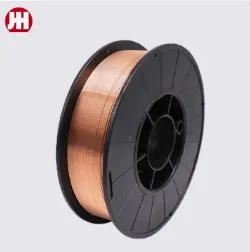Copper Coated vs. Copper Free Welding Wire: What You Need to Know Before You Buy
In the world of gas metal arc welding (GMAW), the type of welding wire you choose plays a big role in productivity, weld quality, and equipment maintenance. Two dominant categories in MIG welding consumables are copper coated welding wire and copper free welding wire—each with its advantages, limitations, and ideal use cases.
Whether you’re sourcing wire for high-speed robotic welding, heavy fabrication, or general maintenance, understanding copper coated welding wire specifications and how they compare to copper-free options is critical to making the right purchase decision.

What Is Copper Coated Welding Wire?
Copper coated welding wire is solid MIG wire that has been electroplated or coated with a thin layer of copper. The copper enhances electrical conductivity between the contact tip and wire, reduces friction through liners, and offers limited corrosion resistance.
Benefits of Copper Coating:
Improved electrical contact: Ensures stable arc and smoother current flow.
Longer contact tip life: Less wear due to better conductivity and reduced heat buildup.
Reduced wire feeding friction: Smoother delivery in long or coiled wire setups.
Oxidation protection: Slows rusting during storage.
The copper coating is usually extremely thin (around 0.5–1.5 μm) and is not meant to affect the weld metal composition significantly.
Copper Coated Welding Wire Specifications
When reviewing copper coated welding wire specifications, pay attention to the following parameters:
|
Specification |
Typical Range / Value |
|
Diameter |
0.8 mm, 1.0 mm, 1.2 mm, 1.6 mm |
|
Coating thickness |
0.5–1.5 μm |
|
AWS classification |
ER70S-6 (common), ER70S-3 |
|
Copper content in coating |
Typically 0.05–0.3% |
|
Wire tensile strength |
~500–620 MPa (for mild steel) |
|
Packaging options |
Spools (15 kg), drums (250–500 kg) |
Most ЭР70С-6 copper coated wires are used for welding mild and carbon steels with CO₂ or mixed shielding gases, especially in applications where smooth feeding and consistent arc characteristics are priorities.
Common Applications
Automotive manufacturing
Shipbuilding and structural steel
Heavy equipment fabrication
Pipe welding
General MIG fabrication shops
What Is Copper Free Welding Wire?
As the name suggests, copper free welding wire does not have any metallic copper coating. These wires are often treated with surface lubricants or passivation layers to ensure feeding quality and corrosion resistance.
Why Go Copper-Free?
While copper-coated wire is the standard, many high-speed and high-volume welding operations are turning to copper free welding wire due to:
Less spatter: Reduced arc instability from inconsistent coating.
Cleaner welding environment: No copper vaporization, which can coat nozzles, sensors, and robot optics.
Lower fume emissions: Particularly in automated shops concerned with air quality.
Improved equipment life: No copper debris clogging liners or contact tips.
These advantages are especially important in robotic or automated welding systems where downtime from wear or maintenance is costly.
Copper Coated vs. Copper Free: Key Differences
|
Feature |
Copper Coated Wire |
Copper Free Wire |
|
Electrical conductivity |
Excellent |
Slightly lower, but acceptable |
|
Friction and feedability |
Very smooth |
Improved via special surface treatments |
|
Spatter and fume |
Moderate (some copper vapor) |
Lower spatter, cleaner arc |
|
Contact tip wear |
Low |
Comparable with high-end copper-free |
|
Cost |
Slightly lower per kg |
Slightly higher, but offset by lower maintenance |
|
Best for |
General fabrication, manual welding |
Automated systems, clean environments |
In many cases, high-quality copper-free wires now match or exceed the arc stability and feeding characteristics of traditional copper-coated wires.
Factors to Consider When Choosing MIG Wire
Welding Process
Manual, semi-automatic, or robotic?
Base Material and Joint Type
Carbon steel? Thin sheet or thick plate?
Shielding Gas
CO₂ vs. Argon/CO₂ mix impacts spatter and penetration.
Welding Position
Some wires are optimized for flat, vertical, or overhead positions.
Feed System Design
Copper-coated may be better for long wire feed distances unless copper-free is specifically designed for it.
Welding Wire Pricing Overview (Estimated 2025)
|
Wire Type |
Price (USD/kg) |
|
Copper Coated ER70S-6 |
$2.00 – $3.20 |
|
Copper Free ER70S-6 |
$2.50 – $3.80 |
|
Stainless MIG Wire (ER308L) |
$5.00 – $7.50 |
|
Aluminum MIG Wire (ER4043) |
$6.50 – $9.00 |
Note: Copper-free wires may seem costlier upfront, but lower fume extraction, reduced maintenance, and longer equipment life can make them more cost-effective over time—especially in automated lines.
Welding Wire FAQs
Q1: Is copper coating on MIG wire dangerous?
A: No, but during welding, copper can vaporize and cause equipment buildup or fumes. In cleanroom or robotic settings, this is a concern—hence copper-free options.
Q2: Can copper-free wire be used with all MIG welders?
A: Yes, but best results come with modern feeders and torches designed for smooth wire handling. Always match wire to your system specs.
Q3: Which wire is better for robotic welding?
A: Copper-free welding wire is generally preferred for robotic welding due to lower fume levels and cleaner equipment operation.
Q4: How do I know if the copper coating is too thick?
A: Excessive copper can flake, cloging liners or interfering with arc stability. Always verify the coating thickness in the product spec.
Q5: Where can I buy copper coated welding wire in bulk?
A: Look for authorized welding distributors, OEM partners, or direct from welding consumables manufacturers. Some brands also offer private-label or custom-spooled wire for large buyers.
-
What is a medium-frequency pulse? What types of welding are suitable for?НовостиNov.24,2025
-
Why is the overall cost of CO2 welding lower than that of shielded metal arc welding?НовостиNov.21,2025
-
Welding Knowledge 6НовостиNov.20,2025
-
What is a low-frequency pulse? What types of welding are they suitable for?НовостиNov.19,2025
-
Why are the weld joints from CO₂ gas shielded welding of such high quality?НовостиNov.18,2025
-
J506 Welding Rod - Low Hydrogen, All-Position, AC/DC E7016НовостиNov.17,2025


